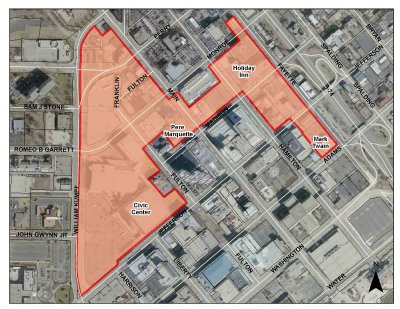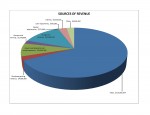The Journal Star is reporting that taxes and/or fees will have to be raised to plug the deficit, according to Mayor Ardis:
Ardis didn’t say which revenue will be increased, other than to say it could be a combination of things, such as a possible sales tax increase or a water utility fee…. The mayor did say it was unlikely the city’s portion of the property tax will be increased, citing other government bodies such as District 150 that have already increased their tax rate. “It would be the absolute last thing we’ll look at,” Ardis said. “(The property tax) is tapped.”
Wait a minute. The reason we can’t raise the property tax is because other taxing bodies have “already increased their tax rate”? That makes absolutely no sense, but let’s just accept it for the sake of argument. Why then should we consider raising the sales tax, considering the county just raised their tax rate? Why doesn’t the same “logic” apply?
And if the city’s revenue-producing abilities are limited because other taxing bodies are raising their rates, then the first thing we need to do is stop giving any of our revenue to those other taxing bodies. For instance, the city should immediately stop giving any tax money to the park district or the school district. Does that mean that there will be no programming on the riverfront? Tough! Does that mean that district 150 won’t get city-provided crossing guards? Sorry! The city needs to use all its available revenue to provide its own core services, not services for other taxing bodies.
Frankly, the mayor’s comments should come as no surprise. A couple council meetings ago, council members were given a packet of information available for download from the city’s website about the budget. Included was this document outlining possible cuts and revenue increases. In fact, since we have that info, here’s what I’d like to do:
I’d like you to pretend you’re a city council member. (You should be feeling a power trip right about now; if you don’t, you’re not pretending right.) Okay, council person? Now, you have to plug a $10 million structural budget deficit by either cutting costs, increasing revenues, or a combination of both.
How would you do it?
You can use the options provided in the aforementioned report, or add your own. It has to be realistic (so, for example, “print money out of thin air like the Federal Reserve” is not acceptable). Also, it has to be a long-term solution because this is a structural deficit. Short-term stop-gap measures don’t count.
Just to make things easier, here’s a summary of options outlined in the report:
INCOME OPTIONS
- Property Tax — Each $.01 added to the levy raises $200,000. The owner of a $200,000 house would pay $6.60 more in property taxes annually per penny.
- Water Utility Tax or Franchise Fee — A 5% utility tax or franchise fee placed on the use of water would yield approximately $1,200,000 each year.
- Sales Tax — An additional .25% increase in the home rule sales tax would bring in an estimated $3,850,000 each year.
- Package Liquor Tax — 2% tax on package liquor would raise about $700,000 annually.
- Parking Tickets — If the $10 fine was raised to $15, an additional $90,000 in revenue annually.
- Garbage Fee — Peoria residential properties pay $6 each month in garbage fees. For every dollar the monthly rate is raised, the City would gain an additional $336,000 annually.
- Motor Fuel Tax — The City currently collects $.02 per gallon of fuel sold. For every penny added, approximately an additional $400,000 in revenue.
- Stormwater Utility Fee — Rough estimates indicate charging $2.00 per month per “residential unit” would generate about $1.2 million.
COST-CUTTING OPTIONS
- Wage Adjustment — Cutting the salary increases of staff from 4.75% (union) and 3.5% (management) to 2.5% across the board would save $1,839,113.64. Cutting them to 1% would save $3,088,880.53.
- Voluntary Separation Initiative — No amount given, but the idea would be to offer early retirement to long-time employees who make high salaries, thus reducing the total payroll.
- Service Cuts/Layoffs — Again, no amount given, since it would depend on which services the city decided to cut. What services do you think should be eliminated? We may be able to find out how much such a cut would save.
- Medical Premium Increase — If the rate at which employees participated in the base premium cost were raised by 5% for all types of coverage, the City would save an estimated $811,000 in FY2010, based on 2009 premium costs. A family membership in the PPO would cost the employee $408.92 each month vs. the current rate of $272.61.
- Reduce Capital Budget — For FY2009, Council approved a Community Investment Plan that funded $21,434,873 worth of projects. Of that amount, only $8,908,895 was in discretionary spending (funding sources not strictly limited to capital projects). This amount represented only 55% of the project funding ($17M) identified by staff and Council.
- Use of HRA Taxes — The primary and obligated use of the proceeds of the Hotel-Restaurant-Amusement Tax is to pay down the Civic Center bonds. Annually, any revenue remaining after bond payments is apportioned by agreement to the Civic Center Authority, Peoria Area Convention and Visitor’s Bureau, ArtsPartners and other community organizations. Many communities use their HRA taxes to support operating or capital projects.
Okay, you have the raw data. Now find $10 million. On your marks. Get set. Go!


 The
The 
